Abstract
Lightweight insulation materials are widely used in lightweight buildings, cold-chain vehicles and containers. A kind of insulation composite, which can combine the super insulation of state-of-the-art insulation materials or structures and the machinability or adaptability of traditional insulation materials, was proposed. The composite consists of two components, i.e., polyurethane (PU) foam as the base material and vacuum insulation panel (VIP) or silica aerogel as the core material. The core material is in plate shape and covered with the base material on all sides. The thermal conductivity of the core material is nearly one order lower than that of the base material. The effective thermal conductivity of the insulation composite was explored by simulation. Simulation results show that the effective thermal conductivity of the composite increases with the increase of the thermal conductivity of the core material. The effective thermal conductivities of the composites decrease with the increase of the cross-section area of the core material perpendicular to heat flow direction and the thicknesses of the core material parallel with heat flow direction. These rules can be elucidated by a series-parallel mode thermal resistance network method, which was verified by the measured results. For composite with a VIP as the core material, when the cross-section area and thickness of the VIP are respectively larger than 60% and 21% of the composite, the composite’s effective thermal conductivity can be 50% or less than that of the base material. Simulated heat loss of the envelope adopting the insulation composites with VIP as the core material is nearly a half of that of the envelope adopting traditional insulation materials.
1. Introduction
Lightweight insulation materials, with the advantages of high insulation and light weight, are widely used in envelopes such as lightweight buildings [1], cold-chain logistics vehicles and containers. To achieve excellent insulation, it is more advantageous to decrease the thermal conductivity of the envelopes than to increase their thickness.
Insulation materials can be classified into traditional, state-of-the-art and future materials [2]. Traditional insulation materials, including natural materials, inorganic fibre materials and organic foam materials, have been widely used. Many traditional materials can be perforated or cut onsite, without loss of bulk thermal resistance. Polyurethane (PU) [3,4], one of traditional materials, is a polymer foam formed by a reaction between isocyanates and polyols. Closed pores are filled with a low thermal conductivity gas, resulting in a relatively low effective thermal conductivity in the range of 0.02–0.03 W/(m·K) [5]. State-of-the-art materials refer to the thermal insulation materials with the lowest thermal conductivity presently available. Vacuum insulation panel (VIP) [6,7,8] is a representative of the state-of-the-art materials and consists of a vacuumed open porous core of glass fibre or fumed silica powder and several polymer laminate layers to protect the vacuum inside. Because convective heat transfer is eliminated, the effective thermal conductivity of VIP is as low as 0.003-0.004 W/(m·K) and is approximately 20% of that of the aforementioned traditional materials. Even if the vacuum loss over time and the thermal bridging of the envelope are considered [9], the thermal conductivity is still as low as 0.006–0.008 W/(m·K). Another transparent or translucent VIP, used as a window or curtain, has been developed recently [10,11]. However, VIPs have some inevitable defects in adaptability or machining. The aging characteristics of a VIP are highly dependent on the sealing performance of its envelope. If water vapor or air permeates into the VIP core material through the envelope, the thermal conductivity of the VIP will increase remarkably. Another major disadvantage of VIPs is the fact that they cannot be cut for adjustment or perforated without losing a large portion of their thermal insulation performance. Aerogel is another typical state-of-the-art insulation material with high porosity and low apparent density. Because the average pore diameter of aerogels (between 20 and 40 nm [12]) is smaller than the mean free path of air molecules and Knudsen effect suppresses the gaseous conduction and convection, aerogels have a relatively low thermal conductivity. At ambient pressure the thermal conductivities of commercially available aerogels are as low as 0.013-0.014 W/(m·K) [13]. Aerogels can be produced as opaque, translucent or transparent materials and are widely used in lightweight envelopes, but aerogels have a low tensile strength and their durability under long-term service is poor. Future materials, including vacuum insulation materials, gas insulation materials, nano-insulation materials and so on, are currently still only found and used in the lab because of their complex preparation technology and high cost.
A kind of insulation composite with excellent integrated performance and low production and application cost obtained by combining state-of-the-art insulation materials and traditional insulation materials has been proposed. VIPs covered by polystyrene or polyisocyanurate foam boards have been studied by experimental and simulation methods [14,15,16], and showed a thermal resistance 100% higher than that of the traditional insulation materials.
In this paper, the influences of the dimensions and thermal conductivities of the thermal insulation materials on the effective thermal conductivity of the composites are analyzed by theoretical, simulation and experimental methods. Furthermore, the insulation performance of the new insulation composite in the envelope of a cabin is numerically studied.
2. Materials and Methods
2.1. Materials
To achieve excellent insulation and high adaptability, the composites are constructed with PU foams as the base materials and VIPs or aerogels as the core materials as shown in Figure 1.
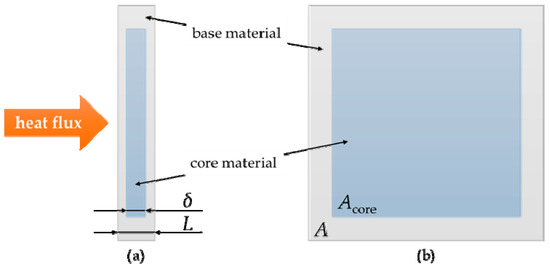
Figure 1.
Schematic of the insulation composite model.
When the composite is prepared, the material with a lower thermal conductivity plays a role as the core material and is covered by the base material with a higher thermal conductivity. The thermal conductivities of the materials used in the simulation are listed in Table 1. It is obvious that the thermal conductivity of PU is one order of magnitude higher than that of VIP, and double that of aerogel.

Table 1.
Thermal conductivities of the insulation materials.
2.2. Simulation Model and Resistance Network of the Composite
A finite element method is used to establish models for steady-state heat transfer in the composite plates. In the simulation, the core and base materials are assumed to be homogeneous and isotropic. The top and bottom sides are at different temperatures of T1 and T2, and the periphery of the plate is adiabatic. If q is the heat flow through the plate, according to Fourier’s law, the effective thermal conductivity of the composite (keff) can be calculated as:
where A is the cross-section area perpendicular to the heat flow direction, L is the composite thickness parallel to the heat flow direction.
The resistance networks are built according to the different combining modes of core and base material’s thermal resistances, as shown in Figure 2. In the series-parallel mode, the resistance of the core material is in series with that of the base materials in the direction of heat flow, and then in parallel with that of peripheral base material. The effective thermal conductivity according to the resistance network can be written as:

Figure 2.
Thermal resistance networks. (a) series-parallel mode; (b) parallel-series mode.
Parallel-series mode means that the resistance of the core material is in parallel with that of the base materials on the plate perpendicular to heat flow, and then in series with that of base materials in the direction of heat flow. The corresponding effective thermal conductivity is shown as:
where kbase and kcore are the thermal conductivities of the base and core materials respectively. δ and L are the thicknesses of the core material and composite respectively. Acore and A are the cross-section area perpendicular to heat flow of the core material and the composite, respectively.
2.3. Measurement of the Thermal Conductivities
Thermal conductivity of the PU foam is measured by the heat flux meter method, and the effective thermal conductivities of VIPs and composites is measured by the steady-state comparative method with calibrated PU plate (20 mm thick) as the reference material. VIPs are provided by Fujian SuperTech Advanced Material Co., Ltd.(Longyan, China), and their sizes are 300 mm × 250 mm × 10 mm (VIP25) and 300 mm × 200 mm × 10 mm (VIP20) respectively. Each of two composites is configured with a VIP covered with the PU foam on all sides, and in the same size of 300 mm × 300 mm × 30 mm.
As shown in Figure 3, in steady-state comparative method, different temperatures (30 and 55 °C, slightly above room temperature) were maintained by metal plates separately connected to two thermostats. Sample and reference material were stacked between the thermostats, and thin aluminum plates were placed on both materials as heat spreaders to sustain uniform temperatures. Foam insulation materials were utilized to prevent peripheral thermal loss.

Figure 3.
The steady-state comparative method for thermal conductivities measurement.
Due to the thermal insulation and the plate-shape of materials, when temperature field reaches a steady state, the heat flux through the sample and the reference material is equal and can be written as:
where L, ΔT and k are the thickness, temperature difference and thermal conductivity respectively. The subscripts “s” and “r” mean the sample and the reference material (PU), respectively.
The thicknesses of the materials were measured by vernier caliper and K-type and T-type thermocouples were used to measure the surface temperatures in the central zones of materials. The experimental error of the thermal conductivity of PU, measured by the heat flux meter method, is approximately 5%.
By taking logarithm and differential of Equation (4), equations could be obtained:
The accuracy of the thickness measurements is 0.02 mm, and that of the temperature measurements is estimated to be 1 °C according to the calibration of thermocouples. The latter significantly increases the experimental errors of thermal conductivities of VIPs and composites, leading them in the range of 13~22%.
2.4. Simulation models for cabin adopting insulation composites
The influence of different core materials on the insulation performances of insulation composites adopted as the envelope of a cabin is studied by calculating the inner surface temperatures and the heat losses from the cabin in dynamic environments by finite element method. The envelopes of the cabins adopt PU and composites in plate shape.
As shown in Figure 4, the cabin with an external size of 2000 mm × 1000 mm × 900 mm is constructed with the insulation material or composite plates of 40 mm thick and stainless steel supporting frameworks. The thickness of the core materials in the insulation composites is 30 mm, and their length and width is 90% of the composite. Thermal contact resistances between different materials are ignored. The air temperature inside the cabins is set as 20 °C in constant, and the convective heat transfer coefficients of the inner and outer surfaces of the cabins are 10 and 25 W/(m2·K) respectively. The meteorological data, including solar irradiance and air temperature, are retrieved from the database of Medpha. 24th June in Kashgar and 1st January in Mohe are chosen as the typical weather days and regions.
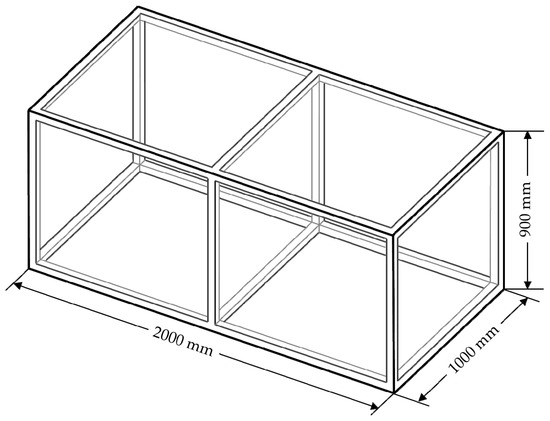
Figure 4.
Schematic of cabin for the thermal insulation performance study.
3. Results and Discussion
3.1. Resistance Networks and Simulation Models
A more suitable thermal resistance network mode should be chosen from the two modes by the comparison of the results with the simulation ones. Both the networks are built for the composites with the core material of VIP or aerogel. The relationships between one of the dimension parameters and the effective thermal conductivity of the composite are showed in Figure 5. The dimensions of all these composites are the same and in plate shape of 1000 mm × 1000 mm × 40 mm. In Figure 5a the thickness of the core materials is 20 mm and In Figure 5b the cross-section area of the core materials is 0.64 m2. It is obvious that the results from two thermal resistance networks are different from the simulation ones and that from the series-parallel mode are closer to the simulated ones, with a deviation in 4%.
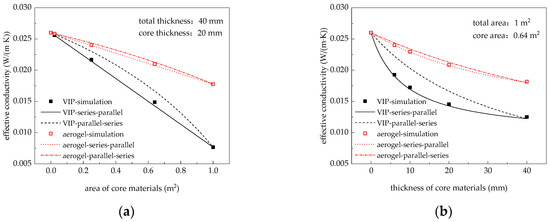
Figure 5.
Effective thermal conductivities of composites with VIP or aerogel as core material from simulation and thermal resistance networks. (a) For constant thickness of the core material; (b) for constant cross-section area of the core material.
There is multi-dimensional heat transfer effect in reality and the simulation. In series-parallel mode resistance network, the cross-section heat transfer is not considered, leading to a thermal conductivity a little lower than the simulated one. In parallel-series mode resistance network, the thermal conductivity is much higher than the simulated one because of the assumption of the equivalent temperature on the cross section of the core material and the neglect of the thermal bridge effect in the base materials. There is a nearly linear decreasing relationship between the effective thermal conductivity of the composite and the cross-section area of the core material, and a nearly inverse proportional relationship between the effective thermal conductivity of the composite and the thickness of the core material. The declines of the effective thermal conductivities with the increase in the cross-section area or thickness of VIP core materials are larger than that of the composite with aerogel as the core material.
To analyze the influences of the dimension parameters of the core materials on the effective thermal conductivities of the composites and obtain a graph for reading the effective thermal conductivities of the composite with the core material in different dimensions, the series-parallel mode resistance network is chosen and the results are showed in Figure 6. The impact of the cross-section areas of the core materials on the effective thermal conductivities of the composites is insignificant when the core material is thin, and the effective thermal conductivities decreases rapidly with the increasing cross-section area of the core material when the core material is thicker. The principle is the same if the cross-section area is in the place of the thickness. When the cross-section area and thickness of the VIP are respectively larger than 60% and 21% of that of the composite, the effective thermal conductivity of the composite can be 50% or less of that of the base material.
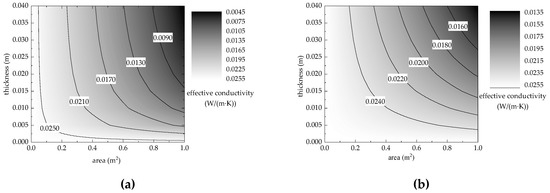
Figure 6.
Effective thermal conductivity of composite over dimension of core material. (a)VIP; (b) aerogel.
The influence of the thermal conductivity of the core material on the effective thermal conductivity of the composite is also analyzed by the series-parallel mode resistance network. The size of the core material is 900 mm × 900 mm × 30 mm. Results are shown in Figure 7, and indicate that the effective thermal conductivities of the composites increase with the increase thermal conductivities of the core materials.
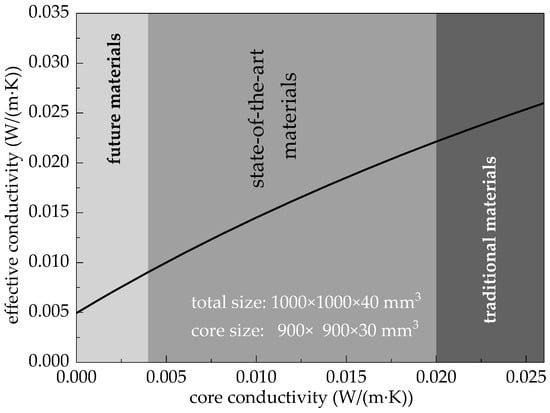
Figure 7.
Influence of thermal conductivity of core materials on effective thermal conductivity of composite.
3.2. Measured Results
The measured thermal conductivities of the PU foam, VIPs and composites are shown in Figure 8. The thermal conductivity of the PU foam is 0.025 W/(m·K). The effective thermal conductivities of the VIPs are below 0.01 W/(m·K) and that of the composites are between that of the PU and corresponding VIPs. The effective thermal conductivities of the larger VIP (VIP25) and the corresponding composite are lower than that of the smaller VIP (VIP20) and the corresponding composite. The thermal conductivities of the VIPs calculated by series-parallel mode resistance network are approximately 0.002 W/(m·K), shown as the hollow symbols in Figure 8, which are in the same order with but lower than the measured ones (0.006 and 0.009 W/(m·K)). The effective thermal conductivities of the VIPs are in the same order with that of different VIP products listed in [7].
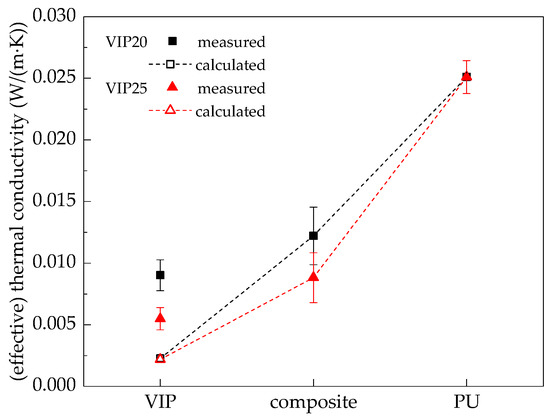
Figure 8.
Thermal conductivities of VIPs, PU and their composites.
Because the thermal conductivity of the foam insulation materials is higher than that of the VIP, a thermal bridge is formed around the VIP. The heat is conducted through the thermal bridge to the aluminum plate upon the VIP, resulting in an increased temperature of the aluminum plate. Thus, the temperature difference between the two sides of the VIP is smaller than expected, leading to a larger measured effective thermal conductivity of the VIP.
3.3. Insulation Performance of Composites in Cabin Envelope
The temperatures at the inner surfaces of the cabins with different envelope composites were obtained and the temperatures at the ceilings are shown in Figure 9. In 1st January in Mohe, the average temperature at the inner surface of the envelope with VIP as the core material is 1.98 °C higher than that of the envelope with no core material and the temperature difference is 0.98 °C for the envelope with aerogel as the core material. In 24th June in Kashgar, the average temperature at the inner surface of the envelope with VIP as the core material is 1.72 °C lower than that of the envelope with no core material in daytime and the temperature difference is 0.84 °C for the envelope with aerogel as the core material. The results show that the temperatures at the inner surfaces of cabins adopting the insulation composites are closer to the air temperature controlled inside. The average heat losses from the cabins are listed in Table 2. Compared to the cabin adopting PU, the heat loss can be reduced by 44.5% or 22.7% by adopting the insulation composite with VIP or aerogel as the core material.
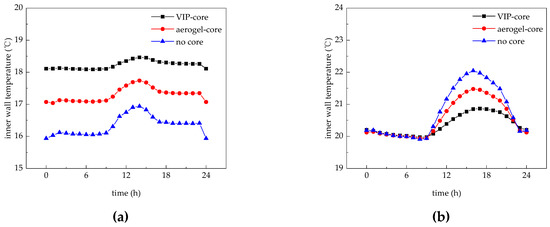
Figure 9.
Inner temperature at ceiling of cabins in two weather conditions. (a) 1st January in Mohe; (b) 24th June in Kashgar.

Table 2.
Average heat loss of cabins with different core materials wall in two weather conditions.
4. Conclusions
In conclusion, a kind of insulation composite with state-of-the-art core material (such as VIP or aerogel) covered by a traditional base material (PU) is proposed. The influences of the dimensions and thermal conductivities of the core materials on the effective thermal conductivities of the composites are discussed. The simulation results indicate that the effective thermal conductivities of the composites increase with the increase of the thermal conductivity of the core material, and decrease with the increase of the dimensions of the core material. These rules can be elucidated by a series-parallel mode thermal resistance network. The relationship between the thermal conductivities of the composites and that of PU and VIPs is verified by the measured results. For the composite with a VIP as the core material, when the cross-section area and thickness of the VIP are larger than 60% and 21% of the composite respectively, the composite’s effective thermal conductivity can be 50% or less than that of the base material. In the simulation of the cabins with the insulation composite as the envelope, the heat loss from the cabin adopting the insulation composite with VIP as the core material is nearly a half of that adopting PU, showing a much improved insulation performance of the composites.
Author Contributions
All authors contributed equally to this work. Detailed contribution is described as follow: conceptualization, H.Y.; simulation, W.T. and Y.X.; experiment and writing, L.G.
Funding
This research was funded by the National Natural Science Foundation (No. 51576188).
Conflicts of Interest
The authors declare no conflict of interest.
References
- Schiavoni, S.; Bianchi, F.; Asdrubali, F. Insulation materials for the building sector: A review and comparative analysis. Renew. Sustain. Energy Rev. 2016, 62, 988–1011. [Google Scholar] [CrossRef]
- Jelle, B.P. Traditional, state-of-the-art and future thermal building insulation materials and solutions—Properties, requirements and possibilities. Energy Build. 2011, 43, 2549–2563. [Google Scholar] [CrossRef]
- Zia, K.M.; Bhatti, H.N.; Bhatti, I.A. Methods for polyurethane and polyurethane composites, recycling and recovery: A review. React. Funct. Polym. 2007, 67, 675–692. [Google Scholar] [CrossRef]
- Atiqah, A.; Mastura, M.T.; Ali, B.A.A.; Jawaid, M.; Sapuan, S.M. A Review on Polyurethane and its Polymer Composites. Curr. Org. Synth. 2017, 14, 233–248. [Google Scholar] [CrossRef]
- Zhang, H.; Fang, W.; Lia, Y.; Tao, W. Experimental study of the thermal conductivity of polyurethane foams. Appl. Therm. Eng. 2017, 115, 528–538. [Google Scholar] [CrossRef]
- Alam, M.; Singh, H.; Limbachiya, M. Vacuum Insulation Panels (VIPs) for building construction industry–A review of the contemporary developments and future directions. Appl. Energy 2011, 88, 3592–3602. [Google Scholar] [CrossRef]
- Kalnæs, S.E.; Jelle, B.P. Vacuum insulation panel products: A state-of-the-art review and future research pathways. Appl. Energy 2014, 116, 355–375. [Google Scholar] [CrossRef]
- Fricke, J.; Schwab, H.; Heinemann, U. Vacuum insulation panels—Exciting thermal properties and most challenging applications. Int. J. Thermophys. 2006, 27, 1123–1139. [Google Scholar] [CrossRef]
- Kontogeorgos, D.A.; Atsonios, I.A.; Mandilaras, I.D.; Founti, M.A. Numerical investigation of the effect of vacuum insulation panels on the thermal bridges of a lightweight drywall envelope. J. Facade Des. Eng. 2016, 4, 3–18. [Google Scholar] [CrossRef]
- Yang, Z.; Katsura, T.; Aihara, M.; Nakamura, M.; Nagano, K. Development of Numerical Heat Transfer and the Structural Model to Design Slim and Translucent Vacuum Layer Type Insulation Panels to Retrofitting Insulation in Existing Buildings. Energies 2017, 10, 2108. [Google Scholar] [CrossRef]
- Yang, Z.; Katsura, T.; Aihara, M.; Nakamura, M.; Nagano, K. Investigation into Window Insulation Retrofitting of Existing Buildings Using Thin and Translucent Frame-Structure Vacuum Insulation Panels. Energies 2018, 11, 298. [Google Scholar] [CrossRef]
- Dorcheh, A.S.; Abbasi, M. Silica aerogel; synthesis, properties and characterization. J. Mater. Process. Technol. 2008, 199, 10–26. [Google Scholar] [CrossRef]
- Gutiérrez-González, S.; Gadea, J.; Rodríguez, A.; Junco, C.; Calderón, V. Lightweight plaster materials with enhanced thermal properties made with polyurethane foam wastes. Constr. Build. Mater. 2012, 28, 653–658. [Google Scholar] [CrossRef]
- Nussbaumer, T.; Wakili, K.G.; Tanner, C. Experimental and numerical investigation of the thermal performance of a protected vacuum-insulation system applied to a concrete wall. Appl. Energy 2006, 83, 841–855. [Google Scholar] [CrossRef]
- Biswas, K. Development and Validation of Numerical Models for Evaluation of Foam-Vacuum Insulation Panel Composite Boards, Including Edge Effects. Energies 2018, 11, 2228. [Google Scholar] [CrossRef]
- Biswas, K.; Desjarlais, A.; Smith, D.; Letts, J.; Yao, J.; Jiang, T. Development and thermal performance verification of composite insulation boards containing foam-encapsulated vacuum insulation panels. Appl. Energy 2018, 228, 1159–1172. [Google Scholar] [CrossRef]
© 2018 by the authors. Licensee MDPI, Basel, Switzerland. This article is an open access article distributed under the terms and conditions of the Creative Commons Attribution (CC BY) license (http://creativecommons.org/licenses/by/4.0/).